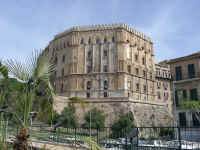|
Page 1 2 3 4 5 6 7 8 9 10 11 12 13 14 15 16 17 Thursday, 5 April. We woke to a day that was sunny but cool. We had a light buffet breakfast
at 8:15. We were somewhat shocked to find that the only coffee was self-service from an
elaborate dispenser that offered numerous choices and combinations, but all made with instant
coffee. We were disappointed because the delicious cafe latte, made with fresh espresso, is one
of the joys of visiting Italy. Like most of Sicily's costal cities, Palermo has had a great variety of rulers. It was founded by the Phoenicians in the 8th century B.C. and was taken over by Carthage two centuries later. Being in the northwestern corner of the island, Palermo didn't come under the Greeks like the eastern and southern coasts. However, it came under Roman domination in the 3rd century B.C. when Rome defeated Carthage. After the fall of the Roman Empire, the city was ruled by the Goths for a time before becoming a Byzantine possession in the 6th century A.D. Then in 831 it was conquered by the Arabs who made it the capital of Sicily. When the island became a Norman kingdom around 1100, Palermo remained the capital. Soon after, the Kingdom of Sicily became the most prosperous country in Europe. After only a century, the Norman kings were succeeded by the (German) Schwabians; then by the French; then eventually, after much going back and forth, by the Spanish. In the 18th century, Sicily passed briefly to Austria, then back to Spain. Of course, the French under Napoleon came for a time; then Sicily went back to the Spanish until Italy was united about 1860. Palermo has many monuments and works of art reflecting this polyglot history. But
despite its ancient heritage, Palermo doesn't have any significant ancient ruins. Due to the city's
prosperity during the Byzantine, Saracen and Norman periods, new structures were constantly
being built, often on the foundations of much older ones. In the city, itself, the oldest surviving
structures seem to be those of the Normans.
One of these is Palermo's cathedral, Santa Maria Assunta. When the Normans took
Palermo from the Saracens in 1072, they promptly reconsecrated the Great Mosque as a Christian
church. Construction of the present cathedral began soon after, but it wasn't completed for
another century (1185). Arab records mention the existence of a large "pagan" (i.e., Byzantine
Christian) temple on the site when they conquered Palermo in 831. Scholars believe that, before
that, both a Carthaginian and later a Roman temple once occupied the site. The remains of
William the Conqueror's brother (Odo of Bayeaux) are interred in the cathedral.
The Norman's didn't expel the Saracens when they took control of Sicily, and they used Arab artisans to do their building. Their architecture clearly show this influence, especially in the pointed arches and windows. We visited the chapel containing the royal tombs of Norman King Roger II, German Emperor Frederick II , Holy Roman Emperor Henry VI (father of Frederick)
Leaving the Norman Palace after 5:30, we boarded our bus again. Enzo, the driver, battled patiently through the almost unbelievably heavy traffic. Apparently the historical value of the city center is so great that no streets can be built or widened. Eventually we reached our destination, a small theater where we were to see a puppet show. We were told that such shows were the first form of drama after the Greeks and Romans. Because most people were illiterate, the puppet shows were the primary means of teaching them about history, heavily interspersed with legend. not to mention a great deal of propaganda. The plays presented are all "classics" to such an extent that Sicilians of all ages know them, and the characters in them, by heart. The play we saw was enjoyable, perhaps made more so by the unrestrained cheering and jeering of the children in the audience. We had dinner in a trattoria at 7:15 and the bus was on its way by 8:00. If anything, the traffic was even worse. Nevertheless, we were back at the hotel in Trabia by 9:00 and in bed by 10:00. Page 1 2 3 4 5 6 7 8 9 10 11 12 13 14 15 16 17
Copyright © 2000-2023 DarrellPeck.com All rights
reserved. | |||||








